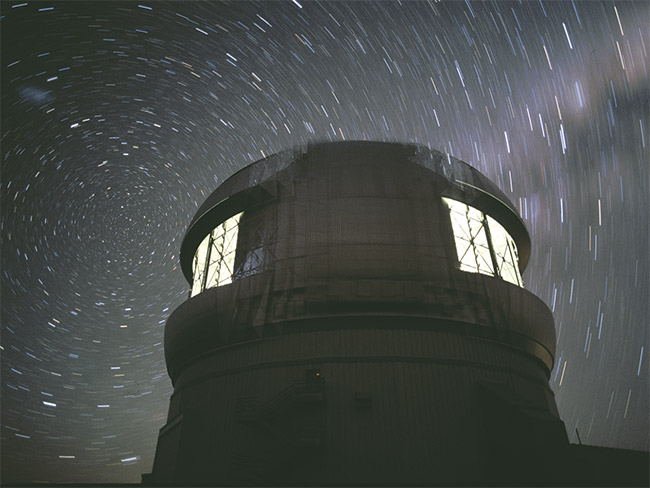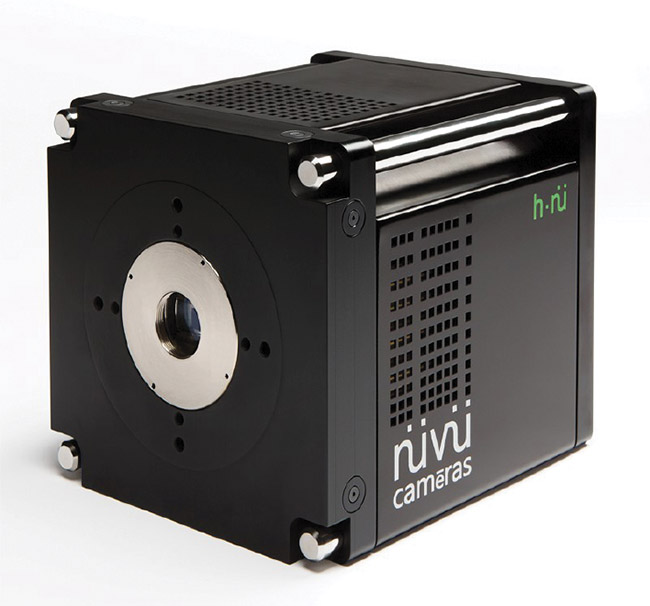EMILE BEAULIEU, NÜVÜ CAMERAS
At the heart of every imaging system, from endoscopes to extremely large telescopes, is the pursuit of a perfect image, extracting as much information as possible from every acquired photon. No matter how well designed the system, however, influences from the target’s ever-changing environment will limit image quality. Adaptive optics (AO) permits the ambitious goal of correcting these effects, pushing measurement precision beyond its usual constraints.

The images captured by earthbound telescopes can suffer from atmospheric distortions. Adaptive optics are helping to compensate for these distortions and enable new tools in the search for exoplanets. Courtesy of International Gemini Observatory/NOIRLab/NSF/AURA.
The science of AO is based on the detection and correction of wavefront distortions. These distortions are caused by a variety of external factors, such as the environment between the imaging system and the target of interest, or vibrations, flexures, and thermal gradients within the imaging system itself. Regardless of the source, these aberrations can deform the targeted object in a captured image. AO uses images of a known reference target to quantify such distortions and subsequently correct them in the final image.
An AO system has two main components: a wavefront sensor and a wavefront corrector. Since distortions evolve over time, the sensor component uses a dedicated detector to track these effects in real time during image acquisition. The wavefront corrector — a deformable mirror or liquid crystal array — then physically corrects the captured signal to significantly reduce distortions on the final image. This allows quantitative imaging of fainter objects with higher spatial resolution and contrast.
A variety of applications
This powerful technique has seen extensive use on ground-based astronomical observation systems. While such telescopes can be built markedly larger than their space-based counterparts, their image quality suffers greatly from atmospheric distortions caused by shifting layers of air currents in Earth’s atmosphere. Compensating for these distortions with AO is crucial to image quality. Recently, AO technology has been integrated into the Nancy Grace Roman Space Telescope — NASA’s next flagship mission — using a space-qualified electron multiplying CCD (EMCCD) to correct for vibrations and thermal gradients in the optics.
The technology is not restricted to astrophysics. It is also gaining traction in biomedical applications. Indeed, biological structures of interest are often hidden behind tissue layers that scatter and absorb light that can create wavefront distortions. Correcting the wavefront allows bioscientists to image deeper structures more accurately.
Next-generation AO
One area of research made possible by cutting-edge AO technology is the ground-based search for exoplanets. The observation and subsequent characterization of exoplanets is critical to our understanding of the various mechanisms involved in the formation and architecture of planets and planetary systems, as well as the conditions for the development of life on other worlds. Detecting these potentially habitable planets is a current challenge for even the most advanced instruments and telescope projects because of the planets’ great distance from our solar system. These exoplanets are also much fainter than the stars around which they revolve by up to 1010 contrast in visible light. Unless wavefront distortions are corrected to a very high degree, the light from these planets is lost in the noise created by the constant variations in atmospheric turbulence that distort the stellar light into a bright “halo.” Having a high signal-to-noise ratio is crucial if this data is to be used to characterize an exoplanet’s atmosphere.
Achieving a very accurate AO correction for high-image-quality and high-contrast exoplanet images is challenging since it requires both fast and high-
resolution imaging with minimal light directed to the wavefront sensor. With faster wavefront sensing, turbulence can be followed more accurately to decrease errors caused by additional changes in imaging conditions during the correction period. Higher sensor resolution also opens up advanced wavefront sensing methods that reduce other errors inherent to standard measurement techniques, such as aliasing or cross talk between wavefront modes.

EMCCD cameras offer AO systems cutting-edge wavefront sensing through single-photon sensitivity with subelectron readout noise. Courtesy of Nüvü Cameras Inc.
Such AO techniques are contributing
to the upgrade of the Gemini Planet Imager (GPI) — an instrument of the Gemini South Telescope in Chile, part of the Gemini Observatory — and will help increase the instrument’s sensitivity to allow it to survey a wider variety of exoplanets, such as low-luminosity Jupiter-mass exoplanets.
Christian Marois, an adjunct professor at the University of Victoria and one of the researchers for the Gemini Observatory, said that high-performance wavefront detectors are driving development of next-generation telescope instruments, and that they will become a crucial tool to deliver the necessary image contrast required for the search of habitable planets. Some of the innovative AO methods Marois and his colleagues are studying include pyramidal wavefront sensing and focal plane wavefront sensing, both of which significantly improve AO correction performance.
Pyramidal wavefront sensing will be enabled in GPI by the installation’s new EMCCDs. EMCCDs are well-positioned for extreme-performance wavefront sensing since their multiplication gain grants them single-photon sensitivity with subelectron readout noise. The EMCCD camera used in the GPI upgrade can reach 3000 fps with 240- × 240-pixel full-frame capture. These unique performance characteristics give the instrument the wavefront sensing capabilities it needs to fulfill its near-term ambitions. With the continued improvement of AO emerging through innovative techniques and modern technologies, the field is set for even more exciting discoveries in astronomy, paving the way toward the discovery of an Earth twin.
Meet the author
Emile Beaulieu is an applications scientist at Nüvü Cameras with an engineering physics background. He is passionate about optical technologies and imaging projects in physics, astronomy, and biology.